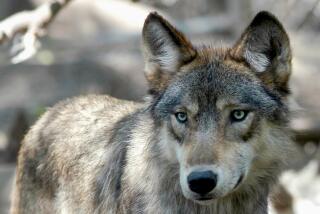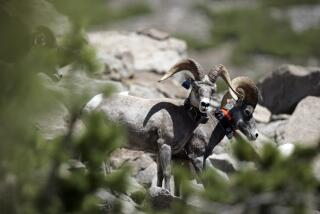Near the site of the Chernobyl nuclear disaster, wildlife bounces back
A new survey of wildlife populations in the radiation-contaminated Chernobyl exclusion zone has found that many mammal species -- including elk, roe deer, red deer, wild boar, lynx and wolves -- seem to be thriving.
The findings, published in the journal Current Biology, hint that when it comes to threats to wildlife, a nuclear disaster may actually be less harmful than human encroachment.
“These results demonstrate for the first time that, regardless of potential radiation effects on individual animals, the Chernobyl exclusion zone supports an abundant mammal community after nearly three decades of chronic radiation,” the study authors wrote.
The research may also help scientists understand the effects of other such disasters, such as the 2011 meltdown of Japan’s Fukushima Daiichi nuclear power plant, on the surrounding wildlife.
The 1986 accident at the Chernobyl nuclear power plant in Ukraine in the then Soviet Union was among the world’s most catastrophic nuclear disasters. An explosion and a fire at the plant released a plume of radioactive material into the atmosphere, spreading over several countries and triggering the permanent evacuation of an estimated 116,000 people from the 1,622 square-mile Chernobyl exclusion zone.
But wild animals can’t be told to evacuate, and so researchers long thought that the radiation would result in deleterious consequences for the wildlife in the area.
Indeed, the study authors wrote, “Several previous studies of the Chernobyl exclusion zone indicated major radiation effects and pronounced reductions in wildlife populations at dose rates well below those thought to cause significant impacts.”
The new findings show otherwise. For this paper, an international team of researchers tracked animal activity in the Polessye State Radioecological Reserve, the portion of the Chernobyl exclusion zone that lies in Belarus, and whose 836 square miles represent about half of the exclusion zone’s total area. They analyzed population density estimates that were based on winter track survey routes, and compared them with the numbers from other uncontaminated reserves in the area.
“Relative abundances of elk, roe deer, red deer and wild boar within the Chernobyl exclusion zone are similar to those in four (uncontaminated) nature reserves in the region and wolf abundance is more than 7 times higher,” the study authors wrote. “Additionally, our earlier helicopter survey data show rising trends in elk, roe deer and wild boar abundances from one to ten years post-accident.”
They also found that the elk and wild boar populations in the exclusion zone were rising during a period in the early 1990s when those species’ populations were dropping in other former Soviet Union countries – a decline likely brought on by socioeconomic changes leading to rural poverty and poorer wildlife management.
“Our long-term empirical data showed no evidence of a negative influence of radiation on mammal abundance,” the authors wrote.
How is this possible? It seems that any harm from the radioactive fallout is far outweighed by the benefit of not having humans around.
Before the accident, they said, mammal population densities were probably reduced because of hunting, forestry and agriculture – human encroachment on their habitats, in other words.
“Our data on time trends cannot separate likely positive effects of human abandonment of the Chernobyl exclusion zone from a potential negative effect of radiation …. Nevertheless, they represent unique evidence of wildlife’s resilience in the face of chronic radiation stress,” the authors wrote.
Follow @aminawrite on Twitter for more science news.
ALSO:
Coral bleaching epidemic devastates reefs off South Florida
Kids’ feelings about marijuana in sixth grade may predict future risk of drunk driving
Nobel Prize in medicine goes to 3 scientists for work on parasite-fighting therapies







